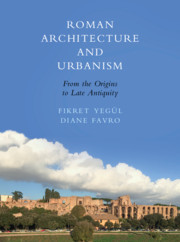Book contents
- Roman Architecture and Urbanism
- Roman Architecture and Urbanism
- Copyright page
- Contents
- Preface and Acknowledgments
- Maps
- Introduction
- 1 Urban Design and Architecture in Rome and Italy during the Republic and the Early Empire
- 2 Temple Architecture of Republican Rome and Italy
- 3 Technology of Building
- 4 Julio-Claudian Architecture in Rome
- 5 Residential Architecture
- 6 Imperial Architecture in Rome from the Flavians through the Antonines
- 7 Architecture and Planning in Italy and the Western Provinces
- 8 Architecture and Planning in North Africa
- 9 Greece under Roman Rule
- 10 Architecture and Planning in Asia Minor
- 11 The Roman Near East
- 12 The Late Empire in Rome and the Provinces
- General Bibliography
- Glossary
- Index
- Plate Section (PDF Only)
Introduction
The Question of Romanization – To Be or Not To Be (Roman)?
Published online by Cambridge University Press: 21 August 2019
- Roman Architecture and Urbanism
- Roman Architecture and Urbanism
- Copyright page
- Contents
- Preface and Acknowledgments
- Maps
- Introduction
- 1 Urban Design and Architecture in Rome and Italy during the Republic and the Early Empire
- 2 Temple Architecture of Republican Rome and Italy
- 3 Technology of Building
- 4 Julio-Claudian Architecture in Rome
- 5 Residential Architecture
- 6 Imperial Architecture in Rome from the Flavians through the Antonines
- 7 Architecture and Planning in Italy and the Western Provinces
- 8 Architecture and Planning in North Africa
- 9 Greece under Roman Rule
- 10 Architecture and Planning in Asia Minor
- 11 The Roman Near East
- 12 The Late Empire in Rome and the Provinces
- General Bibliography
- Glossary
- Index
- Plate Section (PDF Only)
Summary
Few issues in current Roman scholarship proved more engaging and enduring (and occasionally controversial and disruptive) than the discourse on Romanization. The perception of being Roman, or not being Roman, in a world that was dominated or at least administered by the Roman state is a question of central importance to all aspects of Roman Studies in art, architecture, literature, and history. The concept not only opens the door for politically relevant discourse on the nature of cultural and national identities, it also defines the way that we look at art and architecture made by groups with different identities, Roman or other. It seems opportune to add our voice to the chorus here in a generalized and introductory way to offer an overview, although this subject will come up in the following chapters linked to specific historical or regional contexts where it will be discussed further (see the collection of essays in Mattingly 1997, esp. 7–24; also Barrett, 51–64).
- Type
- Chapter
- Information
- Roman Architecture and UrbanismFrom the Origins to Late Antiquity, pp. 1 - 3Publisher: Cambridge University PressPrint publication year: 2019



